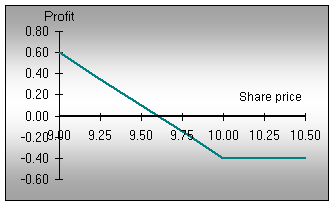Profits and losses
The maximum loss the investor can suffer is the premium paid for the option, which will occur if the share price at expiry is above the strike price. The investor breaks even if at expiry the share price is equal to the strike price of the option less the premium paid. As the share price falls beyond this point, the potential profits of the bought put are limited only by a fall in the share price to zero.
Other considerations
- Time decay: time decay works against the buyer of the put. If the expected share price fall does not take place soon after entering the position, time decay will start to erode the value of the option.
- Strike price: the investor must balance the cost of the option against the fall in share price required for the strategy to be successful. The out-of-the money option will be the cheapest, but also requires the largest fall in share price.
- If the investor is buying a put to protect a shareholding, the cost of the option must be weighed up against the protection required. The in-the-money option locks in the highest sale price for the underlying shares, but also is the most expensive option.
Follow-up action
If the share price fall takes place as expected, the put option taker must decide whether to close out at a profit or maintain the position in the hope of a further increase in price. The longer the option position is left open, the greater the effect of time decay.
If the share price does not fall as expected, it is often advisable to close out the position in order to recover some time value from the position.
At expiry, the holder of an in-the-money put option would usually close out the position, rather than exercising (unless they own the underlying shares). If the put has been bought to protect a shareholding, the investor must decide whether they want to continue holding the stock, in which case the put would be sold, or sell the shares, in which case the option would be exercised.
Points to remember
- Only buy puts when you expect the share price to fall, and volatility to increase.
- If the expected share price fall does not eventuate, be prepared to take a small loss by exiting the position, rather than holding on until expiry and possibly watching your option expire worthless.
- As a shareholder, it is not practical to have protection in place 12 months of the year. This strategy is suitable for shorter periods when you fear a market downturn.

